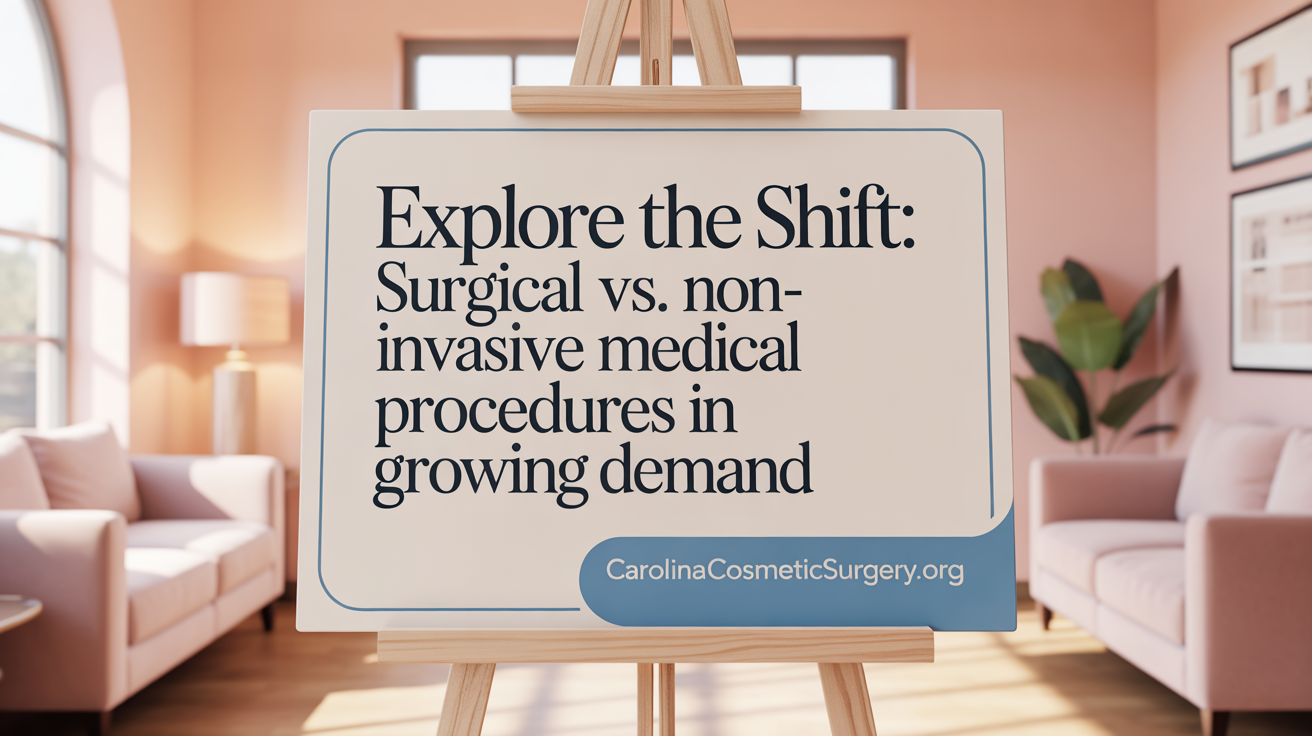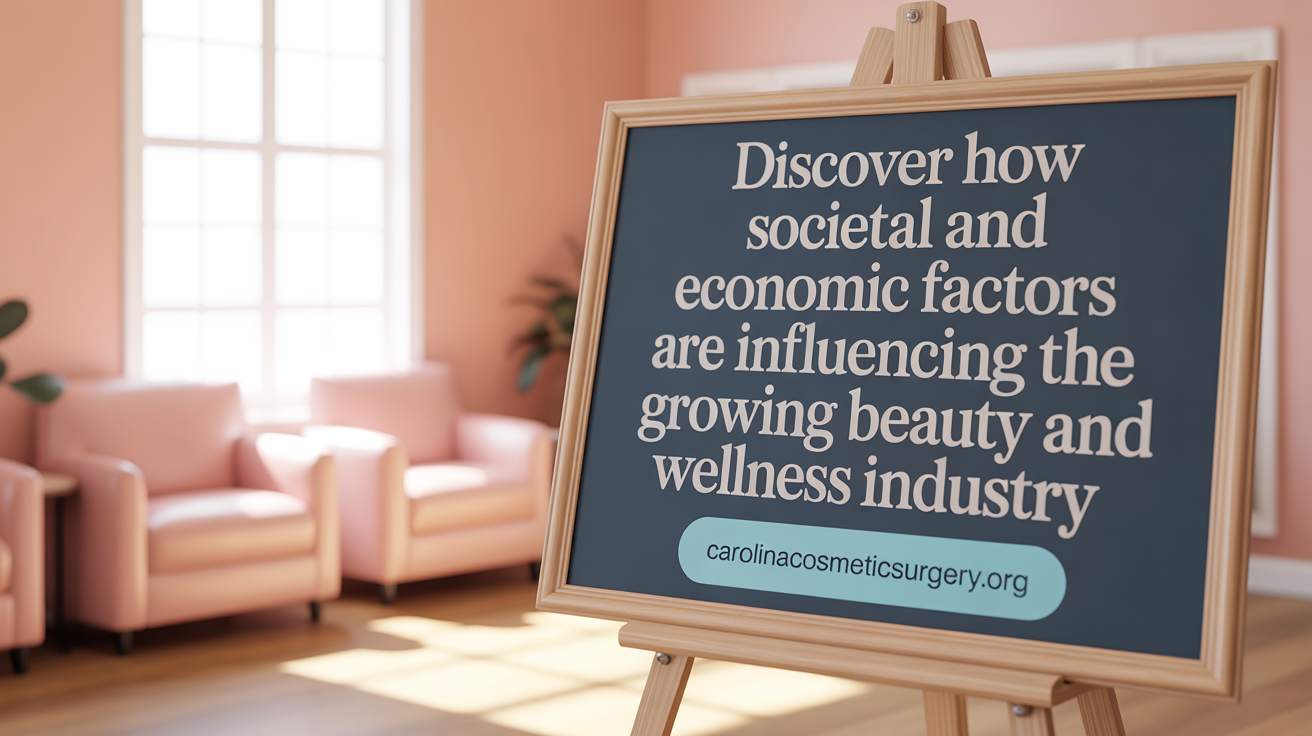A Transforming Industry Fueled by Innovation and Demand
The cosmetic surgery market is on the cusp of remarkable expansion and transformation as it approaches 2025. Driven by technological advancements, shifting societal norms, and an increasing global emphasis on wellness and aesthetic enhancement, the industry is witnessing robust growth in both surgical and non-surgical procedures. This article delves into comprehensive yearly market statistics, explores critical trends, and forecasts the cosmetic surgery sector’s trajectory with detailed insights into regional developments, key drivers, and emerging procedure popularity, setting the stage for what the industry can expect in 2025 and beyond.
Current Market Size and Anticipated Growth Leading into 2030
How large is the cosmetic surgery market and what is its projected growth by 2030?
The global cosmetic surgery and procedure market was valued at approximately USD 112.08 billion in 2022. With ongoing technological advancements, rising societal acceptance, and increasing disposable incomes, it is expected to grow substantially, reaching an estimated USD 332.11 billion by 2030.
This robust growth corresponds to a compound annual growth rate (CAGR) of about 14.7% from 2023 to 2030. North America emerged as the dominant region in 2022, accounting for more than 35% of the market share, driven by high societal value placed on beauty and widespread access to advanced medical technologies.
Meanwhile, the Asia Pacific region is projected to experience the fastest growth, with a CAGR of around 16.5%. Factors fueling this rapid expansion include increasing disposable incomes, cultural shifts favoring aesthetic enhancements, and growing medical tourism.
The market is characterized by a rising preference for non-invasive procedures like Botox, dermal fillers, and laser treatments, which now constitute over half of the total market share. Popular surgical procedures, including liposuction and rhinoplasty, continue to drive fiscal growth, supported by innovations such as 3D imaging and augmented reality for better outcomes.
Overall, the surge in demand is propelled by social media influences, celebrity culture, and a growing global focus on personal appearance, shaping a forecast wherein the cosmetic surgery industry continues to expand systematically over the next decade—becoming a trillion-dollar market by 2030.
Industry Outlook and Market Dynamics Approaching 2025

What is the future outlook for the cosmetic surgery industry leading into 2025?
The outlook for the cosmetic surgery market as 2025 approaches is highly optimistic. The industry is set to continue its growth trajectory, bolstered by rapid technological innovations and a shift toward minimally invasive procedures. Consumer preferences are leaning toward natural results, with greater demand for subtle enhancements over dramatic changes. Procedures like fat grafting, small implants, and skin rejuvenation are increasingly popular because they offer safer options with quicker recovery times.
Emerging treatments such as advanced breast implants like Motiva, rib modeling, and autologous therapies are becoming mainstream, providing patients with more natural and safer outcomes. Younger demographics, particularly Millennials and Generation Z, are showing heightened interest in early aesthetic interventions like mini-facelifts and laser skin treatments, partly due to rising social media influence.
Moreover, societal acceptance of cosmetic procedures continues to grow worldwide, alongside improvements in technology that enhance safety and reduce costs. As a result, the industry is expected to grow steadily through 2025, driven by innovations that prioritize personalized, minimally invasive options that align with evolving consumer expectations for natural beauty and health.
Key Trends Driving the Cosmetic Surgery Industry Through 2025
What are the key trends shaping the cosmetic surgery industry through 2025?
The cosmetic surgery industry is experiencing dynamic changes up to 2025, driven by technological advancements, shifting consumer preferences, and societal influences. A notable trend is the rise in early facial rejuvenation procedures. Patients in their 40s increasingly seek treatments like blepharoplasty (eyelid surgery) and mini facelifts, aiming to address initial signs of aging healthily and subtly.
Simultaneously, there is a growing trend to blend wellness practices with cosmetic treatments. More clinics now offer holistic approaches, including hormone replacement therapy, GLP-1 medications, IV vitamin therapies, and other biohacking techniques. These integrative services appeal to consumers looking for comprehensive approaches to health and appearance.
Minimally invasive technologies continue to dominate the market. Innovations such as Morpheus8 (microneedling with RF), BodyTite (body contouring), Sculptra (collagen stimulator), and PRP (platelet-rich plasma) treatments deliver natural results with minimal recovery time. These procedures are increasingly preferred over traditional surgery due to their safety, convenience, and effectiveness.
Furthermore, there is a rising demand for smaller, safer surgical procedures, especially in breast surgery. Procedures like breast reduction or stand-alone lifts are popular post-childbirth or weight loss, offering tailored solutions that focus on refining natural contours rather than extensive alterations.
Behavioral shifts also influence consumer preferences. Patients now prioritize safety, subtlety, and convenience, sparking a preference for procedures with less downtime and lower risks. Advancements in biological techniques and personalized treatment plans cater to these desires, emphasizing natural and subtle enhancements.
Overall, the industry is characterized by a preference for procedures that are minimally invasive, safe, and capable of delivering natural-looking results. Societal perceptions, fueled by social media and celebrity advocacy, further encourage consumers to pursue refreshers early and regularly, shaping a vibrant and innovative market landscape.
Fastest Growing Cosmetic Surgery Procedure Globally: Labiaplasty
Which cosmetic surgery procedure is currently experiencing the fastest growth worldwide?
Labiaplasty is currently gaining remarkable popularity as the fastest-growing cosmetic surgery procedure globally. Recent data from the International Society of Aesthetic Plastic Surgery (ISAPS) reveals that this procedure saw a 45% increase in 2016 alone. Its growth trend has continued steadily across many nations including the United States, Brazil, Russia, and various European countries.
This surge in popularity can be attributed to several factors. Patients are increasingly motivated by both aesthetic desires and comfort issues, such as discomfort during exercise or chafing caused by enlarged or irregular labial tissues. Many women seek labiaplasty to improve their quality of life and enhance confidence in their bodies.
The rising acceptance and awareness of vaginal rejuvenation treatments also contribute significantly to this growth. More women are now open to discussing intimate health freely and opting for procedures that address aesthetic and functional concerns.
Geographically, the procedure's growth reflects broader societal shifts toward openness about female anatomy and body positivity. As societal norms evolve and stigma lessens, more individuals are exploring labiaplasty as a safe and effective option for personal well-being.
In summary, the rapid increase in labiaplasty procedures signifies a changing landscape in cosmetic surgery, emphasizing intimate health and aesthetic preferences on a global scale.
Regional Market Insights: North America’s Leadership and Asia Pacific’s Rapid Growth

Market share in North America
North America remains the dominant force in the global cosmetic surgery industry, capturing over 35% of the total market in 2024. The United States, as the major contributor, held a market value of approximately USD 20.18 billion and is projected to grow further, reaching around USD 41.29 billion by 2034. This prominent position is driven by high consumer demand, technological innovation, and robust healthcare infrastructure.
Growth drivers in the US and Canada
The growth in North America is fueled by rising disposable incomes, societal emphasis on beauty standards, and the increasing acceptance of minimally invasive procedures. Technological advancements such as AI-guided surgery and novel device integration have enhanced the safety, efficiency, and outcomes of cosmetic treatments. Additionally, cosmetic procedures are culturally ingrained, with a significant number of procedures performed annually—over 18 million in the US in 2022 alone.
Asia Pacific rapid expansion
The Asia Pacific region is experiencing the fastest growth, with a CAGR of approximately 16.5% expected through 2031. Countries like Japan, South Korea, and India are leading this surge, driven by rising disposable incomes, shifting cultural attitudes towards beauty, and the expansion of medical tourism. Increasing urbanization and digital influence also contribute to heightened awareness and demand for cosmetic procedures.
Emerging markets and medical tourism
Emerging markets, particularly in Latin America and the Middle East, are increasingly becoming destinations for medical tourism. Patients seek affordable yet high-quality cosmetic treatments, bolstered by government initiatives, growing local clinics, and global connectivity. The influx of international patients further fuels market expansion in these regions.
Demographic and cultural influences
Demographic shifts, such as aging populations and younger consumers seeking preventative treatments, are shaping market trends. Cultural perceptions of beauty are evolving, with a rising number of men and younger adults opting for procedures. Social media, celebrity endorsements, and online platforms heavily influence aesthetic preferences, making cosmetic procedures more socially acceptable and desired across diverse demographic groups.
Surgical Versus Non-Surgical Procedures: Market Segmentation and Preferences

Revenue share of non-invasive procedures
Non-invasive cosmetic treatments like Botox, dermal fillers, and laser therapies are leading the market, capturing over 50% of total revenues in recent years. Their popularity is driven by shorter recovery times and less discomfort, making them attractive options for a broad demographic.
Popular surgical treatments
Traditional surgeries such as liposuction, breast augmentation, and eyelid surgery remain major contributors to the market. Liposuction, in particular, is the most frequently performed surgical procedure in the U.S., with over 347,000 cases in 2023.
Dominance of botulinum toxin and fillers
Injectables, especially botulinum toxin, are the most dominant non-invasive products, comprising approximately 35% of the market in 2025. Dermal fillers also enjoy high demand, often used complementarily with surgical procedures for enhanced aesthetic results.
Cost comparison of procedures
The average cost of cosmetic surgery in the U.S. is about $5,377, whereas non-surgical treatments typically cost around $1,100. This cost disparity influences consumer choices, with many opting for less expensive, non-invasive options initially.
Shifts in consumer behavior favoring minimal downtime
Modern consumers show a preference for procedures requiring minimal recovery, leading to increased demand for minimally invasive and non-invasive treatments. This trend is fueled by busy lifestyles and the desire to maintain natural results with less disruption.
| Procedure Type | Typical Cost Range | Recovery Time | Popularity Trends |
|---|---|---|---|
| Liposuction (surgical) | $3,000 – $7,000 | Several days to weeks | Most performed surgical procedure in US |
| Breast Augmentation | $6,000 – $12,000 | Weeks | Classic surgical aesthetic option |
| Botox (non-surgical) | $300 – $600 per session | None to a few hours | Fastest-growing non-invasive treatment |
| Dermal Fillers | $600 – $1,000 per syringe | None to a few hours | Widely used for facial enhancements |
| Laser Hair Removal | $200 – $600 per session | None | Increasing popularity for long-term hair removal |
Key Market Players and Their Strategic Roles in Market Expansion

Leading companies in cosmetic surgery
The global cosmetic surgery industry is dominated by major players such as Allergan Inc., Johnson & Johnson, Galderma Laboratories, and AbbVie. These companies have established themselves through extensive product portfolios and strategic market positioning.
Product launches and acquisitions
Innovation is central to market growth, with companies continually launching new products. For instance, Cynosure introduced the PicoSure Pro device, enhancing non-invasive treatment options. Furthermore, acquisitions like Revelle Aesthetics' launch of the Avéli device exemplify strategic moves to expand technological capabilities.
Focus on innovation and technology
Technological advancements are pivotal, driving the industry forward. Developments include AI-guided contour mapping, robotic-assisted procedures, and improved injectables. These innovations make procedures safer, more precise, and accessible, fueling consumer interest.
Collaborations and market strategies
Major corporations are engaging in collaborations to bolster their market presence. Strategic acquisitions and partnerships aim to introduce cutting-edge products, enter emerging markets, and enhance service offerings. For example, companies are expanding their distribution channels and investing in R&D to stay competitive.
Market influence of major corporations
The influence of these key players extends beyond product development. They shape market trends, influence consumer preferences, and drive societal acceptance. By focusing on minimally invasive techniques and leveraging social media advertising, these companies significantly impact the growth trajectory of the cosmetic surgery market.
Technological Advancements Enhancing Safety and Patient Outcomes
How are 3D imaging and augmented reality transforming cosmetic procedures?
3D imaging and augmented reality (AR) are revolutionizing aesthetic treatments by providing surgeons and patients with detailed, realistic visualizations of expected results. These technologies enable precise surgical planning, reducing errors and enhancing confidence in outcomes. Surgeons can simulate procedures in a virtual environment, helping patients see potential results before committing to a procedure.
What role do AI applications and robotic assistance play?
Artificial Intelligence (AI) and robotic systems are increasingly integrated into cosmetic surgery, improving accuracy and consistency. AI algorithms assist in contour mapping, personalized treatment planning, and selecting optimal injection sites for procedures like Botox and dermal fillers. Robotic assistance enhances precision, especially in complex surgeries, leading to better results and minimized risks.
What are the recent innovations in minimally invasive treatments?
Advancements in minimally invasive techniques include improved injectables, laser therapies, and ultrasound devices. These innovations offer less downtime, reduced pain, and quicker recovery, appealing to a broader demographic. For example, new laser devices can tighten skin and smooth wrinkles with minimal discomfort.
How have recovery times and safety profiles improved?
Modern devices focus on making procedures safer and more comfortable. Technologies like radiofrequency-assisted liposuction and energy-based skin tightening allow for safer surgeries with fewer complications and faster healing. Regulatory standards, such as FDA classification of liposuction devices as Class II, ensure safety while encouraging technological progress.
Can you provide examples of cutting-edge devices and techniques?
Emerging devices like the PicoSure Pro laser for skin rejuvenation and Revelle Aesthetics' Avéli for targeted cellulite reduction exemplify current innovations. Techniques such as AI-guided contour mapping, energy-based skin lifting, and bioengineered dermal fillers are paving the way for more personalized and effective aesthetic solutions.
Demographic Shifts Reshaping Demand Across Age and Gender
Increased male participation in cosmetic procedures
Traditionally dominated by women, the cosmetic surgery market is experiencing a significant rise in procedures among men. This shift is driven by changing societal standards that are increasingly accepting of male aesthetics, along with growing awareness of self-care and appearance. Key procedures for men include liposuction, Botox, and facial rejuvenation, with many clinics now tailoring services specifically for male clients.
Rising popularity among younger adults
Younger demographics, particularly those aged 13 to 29, are embracing cosmetic treatments more than ever. Non-invasive options like Botox, dermal fillers, and laser treatments appeal due to their minimal downtime and quick results. Social media influence and celebrity culture prominently shape their perceptions and desirability of aesthetic procedures.
Age group segmentation trends
The 30-54 age group continues to hold the largest share of cosmetic procedures globally, accounting for over 40% in recent years. However, there is an accelerating growth in the older population, particularly those aged 55 and above, seeking anti-aging and facial rejuvenation treatments. This trend aligns with the increase in aging populations worldwide and the desire for a youthful appearance.
Preventive cosmetic treatments
Preventative treatments are gaining popularity among younger adults aiming to maintain their looks over time. These include early use of Botox to prevent wrinkles and dermal fillers to sustain skin volume. Societal acceptance of these procedures is increasing, supported by a rise in wellness and beauty consciousness.
Changing societal acceptance and norms
Society's perceptions of cosmetic surgery are evolving. What was once taboo is now quite normalized, especially with entertainment, social media, and celebrities promoting aesthetic enhancement as part of personal health. This shift aids in expanding market access across diverse demographics, making cosmetic procedures mainstream and accessible to a broader audience.
Market Drivers: Societal, Economic, and Cultural Influences fueling Growth

How do rising disposable incomes contribute to market growth?
Rising disposable incomes worldwide have significantly expanded access to cosmetic procedures. As more individuals can afford aesthetic treatments, both surgical and non-surgical, demand continues to grow. Wealthier populations, especially in emerging markets like Brazil, Mexico, and India, are increasingly investing in enhancing their appearance, leading to increased revenue for clinics and companies.
What is the impact of social media and celebrity culture?
Social media platforms and celebrity influence have reshaped beauty standards and societal perceptions of attractiveness. Trends such as selfie culture and influencer endorsements promote aesthetic enhancements as desirable, encouraging more people to undergo cosmetic procedures. Advanced technologies like 3D imaging and augmented reality also allow potential patients to preview results, boosting confidence and choice.
How do societal pressures and beauty standards drive demand?
Societal pressure for youthfulness and beauty pushes many individuals towards cosmetic surgery and procedures. The desire to conform to evolving beauty ideals often results in increased interest across various demographics, including men and younger adults seeking preventative treatments. The normalization and societal acceptance of these procedures further accelerate market growth.
What role does the aging global population play?
The increasing average age worldwide fuels demand for anti-aging treatments, facelifts, and other age-related procedures. As the elderly population grows, so does the preference for cosmetic interventions that restore a youthful appearance, supporting sustained growth in the industry.
How has accessibility and affordability improved?
Advancements in medical technology, competition among providers, and a broader variety of procedures have made cosmetic treatments more accessible and affordable. Non-invasive options like Botox and dermal fillers offer quicker, less costly alternatives with minimal recovery time, appealing to a larger consumer base.
| Driver | Effect | Regional Impact |
|---|---|---|
| Rising disposable incomes | Increased affordability of procedures | Global, especially emerging markets |
| Social media & celebrity influence | Heightened desire for aesthetic enhancement | North America, Europe, Asia |
| Societal standards & pressures | Push towards beauty conformity | Worldwide |
| Aging population | Increase in anti-aging treatments | Global |
| Tech & cost innovations | Broadened access and choices | North America, Asia, Europe |
The convergence of these influences continues to propel the cosmetic surgery market forward, shaping societal attitudes while fueling technological innovation and industry expansion.
Reconstructive Procedures: A Vital Segment Within the Cosmetic Surgery Space
Post-trauma and post-mastectomy surgeries
Reconstructive procedures are an essential part of the broader cosmetic surgery market, focusing on restoring or improving function and appearance after trauma, illness, or congenital issues. Surgeries such as post-trauma facial reconstructions and post-mastectomy breast reconstructions are designed to help patients regain confidence and normalcy.
Demand and market share
The demand for reconstructive surgeries has increased in recent years, driven by better awareness, improved technology, and societal acceptance. These procedures hold a significant share within the overall market, often overlapping with cosmetic treatments but primarily aimed at restoring anatomy and function.
Technological progress in reconstructive surgery
Advancements in surgical techniques include the use of 3D imaging, tissue engineering, and minimally invasive methods. These innovations improve accuracy, reduce recovery time, and enhance aesthetic outcomes, making reconstructive surgeries more accessible and effective.
Role in overall market expansion
The inclusion of reconstructive procedures contributes to the growth of the cosmetic surgery market. As societal acceptance increases and technology progresses, more patients seek these treatments for trauma or medical reasons, expanding the market’s scope.
Patient quality of life improvements
Reconstructive surgeries significantly improve patients' quality of life, helping them overcome physical and emotional challenges. Successful procedures can restore appearance, confidence, and function, highlighting the critical importance of this segment within the cosmetic surgery landscape.
Economic Impact and Cost Analysis of Cosmetic Procedures
What is the average cost of cosmetic procedures?
In the United States, the average expense for cosmetic surgery is approximately $5,377 per procedure. Non-surgical options like Botox and dermal fillers tend to be less expensive, with average costs slightly over $1,100.
How do costs differ between surgical and non-surgical treatments?
Surgical procedures such as liposuction, breast augmentation, or facelifts generally incur higher expenses due to complexity, anesthesia, and longer recovery times. Conversely, non-invasive treatments like Botox, fillers, and laser therapies offer more affordable options, appealing to a broader demographic.
How do costs influence consumer purchasing decisions?
Affordability and perceived value significantly impact patient choices. As procedures become more accessible, driven by technological advancements and competitive pricing, more consumers are opting for minimally invasive treatments. Additionally, interest among men and younger adults seeking preventive care is rising, often motivated by cost considerations.
Are there insurance or financing options available?
Most cosmetic procedures are elective and not covered by health insurance. However, financing plans, medical credit cards, and payment installments are common, making treatments more financially accessible. These options help expand market reach, especially for higher-cost surgical procedures.
What are the current pricing trends and how do they affect market affordability?
Pricing trends indicate a stabilization in costs, with a gradual decrease in some non-invasive procedures due to increased competition. As technological innovations improve safety and reduce procedure costs, affordability is expected to rise, broadening access and fueling further market growth.
Understanding these cost factors is essential for assessing the economic landscape of the cosmetic surgery industry in 2025, where affordability and technological improvements continue to propel market expansion.
Market Forecasts and Statistical Projections for 2025 and Beyond
What are the long-term market size projections?
The global cosmetic surgery market is expected to experience substantial growth over the coming decade. In 2024, the market was valued at approximately USD 60.22 billion, with projections estimating it will exceed USD 136.55 billion by 2035. Similarly, the broader cosmetic surgery and procedures market is forecasted to grow from around USD 82.5 billion in 2023 to approximately USD 242.6 billion by 2035, reflecting increasing consumer demand and technological advancements.
What is the expected CAGR values?
The compound annual growth rate (CAGR) for these markets varies by region and segment but generally remains high. Globally, the cosmetic surgery market is expected to grow at a CAGR of roughly 7.75% to 10.1% during 2025-2035. Specific sectors, like non-invasive procedures, are forecasted to grow at an impressive CAGR of over 22% between 2024 and 2029, driven by consumer preference for less invasive options.
How will segment growth differ?
Surgical procedures like liposuction, breast augmentation, and facelifts will continue to be significant, but non-surgical treatments such as Botox and dermal fillers are leading growth, owing to their convenience and safety profile. The non-invasive segment is projected to dominate the industry, accounting for around 63% of total industry share in 2025.
What are regional and product-specific forecasts?
North America remains the largest market, holding approximately 30-36% of global revenue, with the U.S. specifically expected to see a CAGR of around 7.4% to 14.7%. Meanwhile, regions like Asia-Pacific are anticipated to register the fastest growth, with CAGR rates surpassing 15%. In terms of products, injectables including Botox and dermal fillers are expected to account for about 35% of the market in 2025, with technological innovations improving results and safety levels.
What about anticipated shifts in market dynamics?
Market shifts will likely include a rising preference for minimally invasive procedures, increased adoption among men and younger demographics, and expansion into emerging markets such as India and Latin America. The integration of advanced technologies like AI-guided procedures and augmented reality is also expected to revolutionize the industry, making procedures more precise and accessible, further fueling growth.
Looking Ahead: The Cosmetic Surgery Market’s Promising Horizon
As we approach 2025, the cosmetic surgery market stands poised for unprecedented growth fueled by a blend of technological creativity, shifting consumer preferences, and expanding global accessibility. The evolving industry reflects a broader societal transformation toward embracing aesthetic enhancement as part of wellness and self-expression. With innovations making procedures safer, more effective, and minimally invasive, and with rising participation across demographics and regions, the market’s future is vibrant and dynamic. Stakeholders including manufacturers, practitioners, and investors should prepare for a landscape marked by rapid expansion, nuanced consumer demands, and a continuing drive toward natural and personalized cosmetic solutions that resonate with an increasingly diverse global clientele.
References
- US Cosmetic Surgery Market Size, Share, Trends, Forecast 2025-2034
- Cosmetic Surgery Market Size, Share | Industry Growth [2032]
- Cosmetic Surgery Market Forecast Report and Company Analysis ...
- Analyzing The CAGR of 7.75% in The Cosmetic Surgery Market ...
- Cosmetic Surgery Market Hits US$ 186.5 Billion By 2033
- Cosmetic Surgery and Procedures Market Statistics - 2035 - Fact.MR
- Cosmetic Surgery Market Size to Hit USD 160.47 Billion by 2034
- Cosmetic Surgery Products Market Demand 2025-2035
- Cosmetic Surgery And Procedure Devices Market Size 2025-2029
